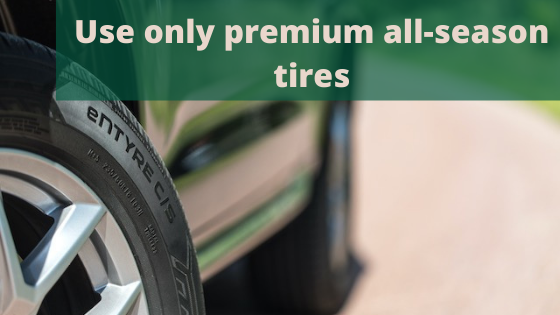One of the trickiest weather situations as the spring approaches is the slush that is created when the snow is melting and you get a mixture of snow and water. Slush is difficult as you will still need to have the properties of snow tires or winter tires, which they are nowadays more commonly referred to as. If you don’t have winter approved tires you don’t have the sufficient properties to handle the snow and cold temperatures without risking that the tires get hard and can’t conform to the texture of the road and therefore lose a substantial part of its grip.
When driving in slush you want to make sure that you have the best possible tires for the situation, that includes premium winter approved tires, tires that are in good physical condition free from any damages and that the tread depth is more than 5/32 inches. Once you go below this level the properties start to decline to a degree that they aren’t safe to drive with anymore. Your braking distance is prolonged and the grip when cornering or trying to stop or accelerate is diminished.
When it comes to slush, the slush has to be able to be pushed through the channels in the tread and if the depth isn’t deep enough you will not have the sufficient volume to push away enough of slush and the risk for slushplaning will increase to a degree where it will almost be unavoidable. This is why you always need to make sure that you measure the tread depth and that you change the tires once you reach this level. It is also important that you rotate the tires when you notice a difference between the front and the rear tires that is bigger than 5/32 inches.
It isn’t only during the spring that you might end up having slush, it can also come during the fall or in areas that have very varying weather, where after you have a big snowstorm the snow will melt away fairly quickly. In these areas it is also good to use winter approved all-weather tires that are able to provide safety in all winter and summer conditions. This is a convenient set of tires for areas where the weather is constantly changing between snowy roads and then back to fall or spring conditions, so that you don’t really have a longer period of winter conditions.
It is important that you don’t try to drive with all-season tires as that is associated with great danger as they aren’t able to provide sufficient safety during winter conditions as the tires get hard and they don’t have enough grip during these conditions. You will need to have a tread that has either studs protruding from it to create grip on ice or then has grip particles added plus that the tires have a tread pattern that can handle snow and slush.
For more information regarding winter approved tires, visit: www.nokiantires.com
